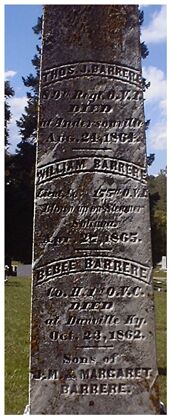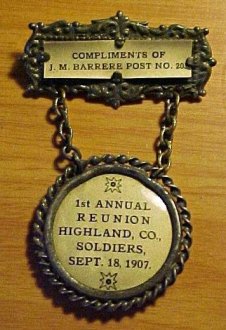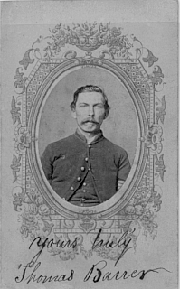Eric Jacobson, in his book Baptism of Fire, honors the numerous casualties from the 175th Ohio Infantry with short captions regarding the events and results of the men’s participation in battle. 2nd Lt. William Barrere is one so listed. William, age 28 at the time, and son of John M. Barrere, was captured at Blockhouse #14 near Columbia, Tennessee on Nov. 25, 1864 and was confined at Andersonville. He perished in the Sultana explosion on his return home to Ohio after the war. He had previously served in the 168th Ohio Infantry before volunteering with the 175th.

The story of the Barrere family only begins here in this post with William. There is so much more! Pictures are used with permission of Joan Asche ( AKA “GoneButNotForgotton” ) except that of Thomas which was contributed by Rob Heideman and “Evening Blues” at “find-a-grave.” Barrere family historians can visit and contact Joan through the “find-a-grave” web-site and her “New Market Pioneers” at http://www.rootsweb.ancestry.com/~ohcnewma

The 1850 census lists John M., age 50, and Margaret Barrere living in Highland County, Ohio with sons James (23), Granville (21), George (18), Thomas (16), William (14), and Bebee (9). Margaret, age 12, is the lone daughter.
The Barrere Family Civil War stories actually begin with John M. Barrere, when at age 62 he enlisted on Oct. 1, 1861 as Adjutant in the 60th Ohio Infantry.
Born in Fleming County, Kentucky, July 11th, 1800. He was the third in a family of twelve children, whose parents were George W. Barrere and Abigail Mills Barrere. In 1861 he assisted in raising and organizing the 60th Regiment and accompanied it into war. At Harper’s Ferry, Virginia he was wounded and lost his left hand. He was taken prisoner by the Confederate forces and subsequently released on parole and returned to his home in Nov. 1862. Source: http://www.rootsweb.com/~ohcnewma/jbarrere.html
Briefly, but still honoring the sons and nephews service as best I can, other family members who also served their nation are:
Son Bebee, age 21, served with 1st Regiment Ohio Cavalry Co. H. Bebee died Oct. 24, 1862. He died in Danville, Kentucky.
Son George, age 32, was a Lt. Col. with the 168th Ohio Infantry (National Guard) Co. A, mustered-out Sept. 8, 1864. George also served one year with the 60th Infantry as a 1st Lt.
Son Thomas, age 28, mustered in as a Sgt. with the 89th Ohio Infantry. He was appointed Corporal later that month. Thomas was captured at Chickamauga and died Feb. 25, 1862 at Andersonville Prison.

Son James, age 37, served with the 2nd Battalion Cavalry Co. A, in 1864. Their duty was to guard the State Arsenal.
Nephew’s Milton, age 18, and Hazzard, age 19, served in the 1st Regiment Ohio Cavalry Co. H. Hazzard was killed at Cleveland, Tennessee Nov. 1863. Milton mustered out Oct. ’64. Records indicate that Milton also served in the 12th Ohio Infantry, but a search of the roster fails to find him. Nephew Nelson, age 23, served in the 168th Ohio Infantry Co. A and the 60th O.V.I.
After the war, on July 4,1865, a large crowd turned out in Hillsboro, Ohio to welcome home some of the men of the 175th regiment, among others, and one of the local dignitaries who spoke that day was John M. Barrere.
Helping to preserve the nation took a heavy toll on him and his family.
Regiments (with histories):
1st Regiment Ohio Cavalry Co. H – Bebee (died), Milton, Hazzard (died)
Duty: organized at Camp Chase from Aug. 17 to Oct. 5, 1861, to serve for three years. In December the regiment broke camp and proceeded by rail and steamboat to Louisville, being the first regiment of cavalry to enter that department. It participated in the advance upon Corinth, having frequent skirmishes with the enemy, and after the evacuation it joined in pursuit of Beauregard’s army, going as far as Booneville. During this pursuit it had four sharp engagements with the enemy, but with little loss. The regiment was constantly engaged in scouting and keeping the country clear of bushwhackers and guerrillas, and a detachment sent out from Tuscumbia, Ala., had a severe engagement with Roddey’s Confederate command near Russellville, and although successful suffered severely. In July Courtland was attacked by a large force of Confederate cavalry under Gen. Anderson, when two companies of the 10th Ky. infantry and Cos. E and K of the 1st Ohio cavalry engaged the enemy, holding him for a considerable time, but were compelled to retire, the enemy having captured the infantry and 21 of the cavalry. Returning to Kentucky with Buell’s army, a battalion moved from Louisville in October, captured 25 prisoners in an engagement near Bardstown, and then took the advance on the Perryville road, carrying it with great gallantry. On the first day of the battle of Stone’s river the regiment made a heroic charge against a foe flushed with success and continued the remaining two days until the victory was complete. On Sept. 19, 1863, the regiment arrived on the Chickamauga battle-field and was immediately led into the fight, its loss in the engagement being severe. It was then stationed at Washington, Tenn., for the purpose of guarding the Tennessee river, and while there the Confederate Gen. Wheeler, with 8,000 cavalry, broke through Gen. Crook’s lines. The Confederate advance was met by a battalion of the 1st cavalry under Maj. Scott and a severe engagement followed, in which 26 men of the battalion were wounded and captured. While on a raid toward Chattanooga in November, the regiment had a severe engagement with the enemy at Cleveland, losing 15 men, but inflicting on the enemy a loss of at least 50. At Calhoun, a town on the Hiawassee river, in December, Gen. Wheeler, with 2,800 men, attacked a wagon-train and this was followed by a brisk engagement, in which the Confederates lost 25 killed, 80 wounded and 131 taken prisoners. This brilliant affair cost the cavalry but 1 man killed and 3 wounded. A sufficient number re-enlisting, it became a veteran regiment and after a furlough of 30 days was back in the ranks ready for duty. In May, 1864, it crossed the Tennessee river at Decatur and three days thereafter participated in the severe engagement at Moulton, resulting in the complete defeat of Gen. Roddey, who had made an attack with a force of six regiments and a battery of artillery. The regiment lost in this engagement about 20 men killed and wounded. It then remained and acted with the main army up to and for some time after the fall of Atlanta, being employed mainly in covering the movements and protecting the flanks. When surrounded by the enemy at Lovejoy’s Station the regiment particularly distinguished itself by holding in check for some time a large part of Cleburne’s Confederate infantry division, with a loss of 50 men. It also took part in the movement which resulted in the evacuation of Atlanta by the Confederates….continued on without a Barrere.
2nd Battalion Ohio Calvary (N.G.), Co. A – James
Duty: Co. A, organized in Highland county, was called out in the month of August to guard the state arsenal, and with Capt. Waddell commanding, served out its term of 60 days in a manner highly satisfactory. At the expiration of their time the men were paid by the U. S. government, and relieved by Co. C, from the same battalion.
12th Ohio Infantry – Milton (?)
60th Ohio Infantry – John (wounded), George, Nelson
Duty: at Franklin, VA May 25, 1862. Pursuit of Jackson up the Shenandoah Valley June. Mt. Carmel Road, near Strasburg, June 1. Strasburg and Staunton Road June 1-2. Harrisonburg June 6. Battle of Cross Keys June 9. Moved to Strasburg June 19-22, thence to Middletown June 24, and duty there till July. At Winchester, Va., till September 2. Evacuation of Winchester September 2, and retreat to Harper’s Ferry. Defense of Harper’s Ferry September 11-15. Bolivar Heights September 14. Surrendered September 15. Paroled as prisoners of war September 16 and sent to Annapolis, Md.; thence to Camp Douglas, Chicago, Ill. Mustered out November 10, 1862. Regiment lost during service 1 Officer and 9 Enlisted men killed and mortally wounded and 2 Officers and 30 Enlisted men by disease. Total 42.
89th Ohio Infantry – Thomas (died)
Duty: Organized at Camp Dennison, Ohio, and mustered in August 26, 1862. Ordered to Covington, Ky., September 3, 1862, and duty there till October 5, during the threatened attack on Cincinnati, Ohio, by Kirby Smith. Ordered to Point Pleasant, W. Va., October 5. Advance to Falls of the Kanawha, Va., October 10-November 3, 1862, thence moved to Fayetteville Court House November 17, and duty there till January 6, 1863. Moved to Nashville, Tenn., January 25-February 7. Relief of 83rd Illinois Infantry, at Dover, from attack by Forest’s Cavalry February 3. Expedition to Carthage, Tenn., February 22-25. Duty at Carthage till June 5. Ordered to Murfreesboro, Tenn., June 5. Middle Tennessee or Tullahoma Campaign June 23-July 7. Hoover’s Gap June 24-26. Tullahoma June 29-30. Occupation of Middle Tennessee till August 16. Chickamauga (Ga.) Campaign August 16-September 22……continued on without Thomas
168th Ohio Infantry (N.G.) Co. A – William, Nelson, George
Duty: At Covington, Ky. they were assigned to protect the Covington & Lexington Railroad line. On June 10 a detachment of 300 occupied Cynthiana. On the morning of June 11 a large force of Confederate cavalry moved against the town, in which engagement the regiment lost 7 men killed, 18 wounded and 280 captured. Later the regiment was then sent to Cincinnati, where it performed guard duty until mustered out on Sept. 8, 1864.
175th Ohio Infantry – William (died)
Duty: see elsewhere on this web-site for History of the 175th
The only Barrere son who (apparently) did not serve actively in the war was Granville. Born in Highland County, Granville attended college and became a lawyer. In 1855 he moved to Illinois to continue his profession. He served as member of the city board of education and as member of the board of supervisors of Canton, IL. He was elected to the United States Congress in 1873 and served two years.
